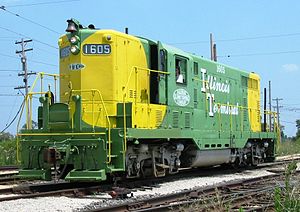EMD GP7
| EMD series GP7 various railway companies |
|
|---|---|
|
EMD GP7 on the Illinois Terminal Railway # 1605
|
|
| Manufacturer: | Electro-Motive Division |
| Year of construction (s): | 1949-1954 |
| Axis formula : | Bo'Bo ' |
| Gauge : | 1435 mm ( standard gauge ) |
| Length over buffers: | 15,544 mm |
| Service mass: | 115.5 t |
| Top speed: | 105 km / h |
| Hourly output : | 1,100 kW |
| Starting tractive effort: | 294 kN |
| Motor type: | EMD 567 B, 2-stroke diesel |
| Power transmission: | electric |
| Number of traction motors: | 4th |
The EMD GP7 is a series of four-axle diesel-electric locomotives from the US locomotive manufacturer General Motors Electro-Motive Division (EMD) of the GP series .
This series EMD came the requirements of railway companies after both shunting - and in line service deployable machine counter. Originally designed as freight locomotives , some examples were also used for passenger transport.
A total of 2,724 machines with a driver's cab (A units) and 5 B units without a driver's cab were built. The latter were only ordered from Santa Fe .
development
The machines of the F series initiated the replacement of the steam locomotives in freight transport of the railways in North America . However, they were only partially suitable for local freight traffic with its extensive shunting maneuvers. Due to the front alignment of the driver's cabs, the view to the rear was severely restricted.
Shunting operations with steam locomotives in particular were extremely uneconomical due to long idle times and frequent starts. Competitors such as the American Locomotive Company (ALCO) made a type of locomotive available that eliminated precisely these points of criticism. EMD had to follow suit. A first attempt to combine a more suitable locomotive body with the mechanical equipment of the EMD F3 was unsatisfactory in operation.
Only in 1949 was the GP7 a product that was competitive with the Alco models.
construction
Technically, the GP7 was based on the F7 . Changes mainly affected the shape of the superstructures. According to the slogan Form follows function published by chief engineer Dick Dillworth , a design was created that deprived everything, as Dillworth put it, Christmas tree ornaments and other nonsense (English: "Christmas tree ornaments and other whimsy") was.
The EMD GP7 had a stable floor frame that carried the entire vehicle mass. In place of the hitherto customary box, there were narrow stems with sides that could be opened almost continuously. This created a very maintenance-friendly design, as all units were easily accessible from the outside. The A-units had a driver's cab that took up the entire width of the vehicle and, in contrast to the E and F series , could drive the machines in both directions. The main direction of travel as a train locomotive is that with the short front end. Behind it was the engine room with the traction generator , which supplied the direct current for the traction motors, and the EMD 567 B diesel engine . The EMD 567 type designation means that the engine had a displacement per cylinder of 567 cubic inches. The vehicles of the early GP series had sixteen-cylinder engines .
The fuel tank was arranged between the bogies and held 4542 liters of diesel oil . A walkway for the shunter was arranged along both sides of the engine casing . This enabled him to get directly from the driver's cab to both ends of the vehicle.
equipment
At the customer's request, the machines were delivered with additional equipment. Many models were delivered with a drag brake. The drive motors convert the kinetic energy into electrical energy and use this to generate heat via braking resistors . As a result, brake wear could be reduced, since the drag brake works without wear. To dissipate the heat to the environment, the locomotives equipped in this way had an additional roof fan, initially with a diameter of 36 inches (914 mm). Later the fan was enlarged to 48 inches (1,219 mm) in diameter. Locomotives with resistance brakes can be recognized by the additional ventilation grilles in the middle of the vehicle.
Some machines were equipped with an additional boiler for train heating. This made it possible to use it in front of passenger trains. In the machines with a heating system, the boiler was built into the short front end. This can be seen from the additional exhaust system.
literature
- Pinkepank, Jerry A .; The Second Diesel Spotters Guide; Kalmbach Publishing Co. Milwaukee; 4th edition 1980; ISBN 0-89024-026-4
- Schneider, Paul D .; GM's Geeps The General Purpose Diesels, Kalmbach Publishing Co. Milwaukee, 1st edition 2001: ISBN 0-89024-573-8
Web links
Individual evidence
- ^ 'Schneider, Paul D .; GM's Geeps The General Purpose Diesels, Kalmbach Publishing Co. Milwaukee, 1st edition 2001: ISBN 0-89024-573-8 ; p. 7th

